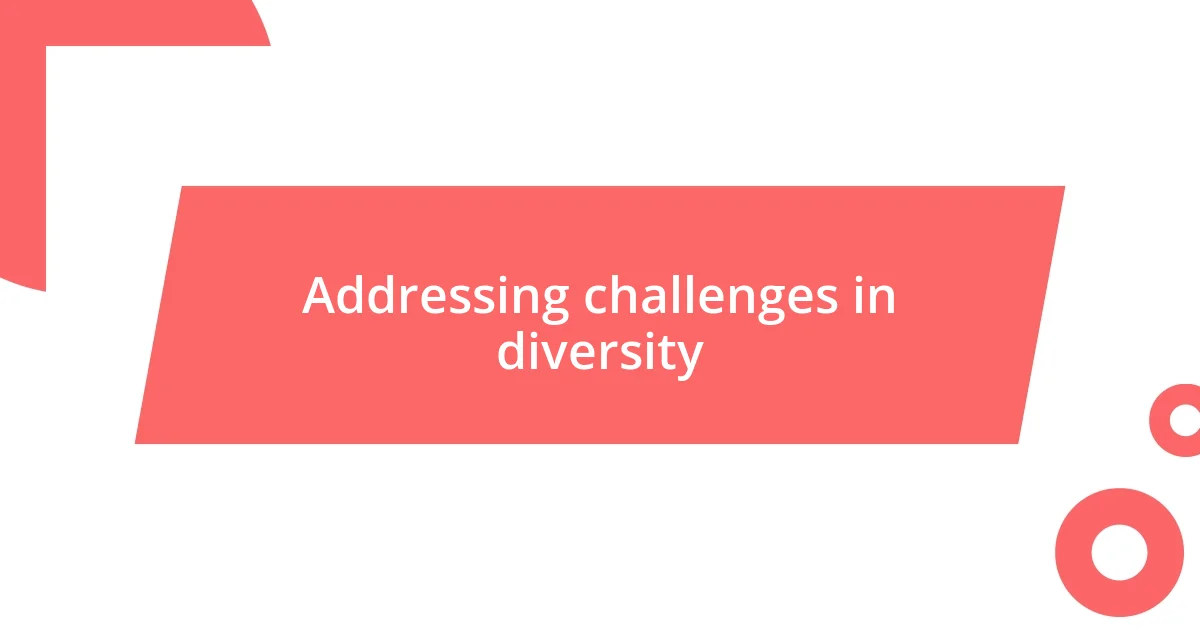Key takeaways:
- Diversity in casting enhances storytelling by bringing authentic experiences, fostering creativity, and deepening emotional connections with audiences.
- Building rapport among diverse actors through cultural exchanges and mentorship increases trust and collaboration, leading to richer narratives and stronger bonds.
- Measuring success goes beyond demographics; it involves audience connection, collaborative spirit, and the community’s engagement with the themes presented in the production.

Understanding diversity in casting
Understanding diversity in casting goes beyond simply checking boxes; it’s about representation that resonates. I remember casting for a community theater production where we opened the floor to actors from all backgrounds. The richness that emerged from those auditions was eye-opening. It made me wonder, why hadn’t we thought of this earlier?
When I watch shows or films that reflect a genuine mix of cultures, it strikes a chord. One vivid memory I have is seeing a production that featured an incredibly diverse cast, and I felt a deep emotional connection. The characters each brought their unique narratives, making the story feel alive and relatable. It made me question— doesn’t storytelling thrive on authenticity?
Diversity in casting isn’t just beneficial; it’s essential for the narrative to flourish. I often find myself reflecting on how limited perspectives can cloud creativity. Every voice brings its own experience, enriching the overall storyline and inviting audiences to empathize on deeper levels. Isn’t it fascinating how a single character, shaped by unique life experiences, can change the entire dynamic of a story?

Benefits of a diverse cast
When managing a diverse cast, one notable benefit is enhanced creativity in storytelling. I’ve seen first-hand how a mix of perspectives can lead to innovative concepts that would’ve never surfaced otherwise. For instance, during one of my productions, an actor shared a personal story that influenced a key plot twist, something that enriched the entire narrative in unexpected ways.
Another advantage is the broader audience appeal. When people see themselves represented on stage or screen, it fosters a sense of belonging and connection. I can recall the overwhelming response we received during a performance featuring a wide range of cultural representations. It was heartwarming to see audience members relate their personal experiences to the characters, transforming a simple show into a shared journey.
Diverse casts also promote learning and understanding among performers and audiences alike. Through collaboration, actors exchange cultural narratives, which I believe helps nurture empathy. At one point, an actor from a different background conducted a workshop, and the entire cast learned about traditions that were completely new to many of us. This not only built camaraderie but also deepened the collective storytelling experience.
| Benefit | Description |
|---|---|
| Enhanced Creativity | Fresh perspectives lead to innovative storytelling ideas. |
| Broad Audience Appeal | Representation fosters connection and belonging. |
| Learning and Understanding | Cultural exchange nurtures empathy among actors and audience. |

Strategies for inclusive auditions
Creating inclusive auditions is a cornerstone of assembling a diverse cast. In my experience, establishing an open atmosphere from the start sets the tone for what’s to come. I recall an audition in which we explicitly encouraged actors of all backgrounds to bring their authentic selves. The energy in the room was electric; you could almost feel the differing life stories colliding, creating a vibrant tapestry of talent.
Some strategies I’ve found extremely beneficial include:
-
Broadening the Outreach: Advertise auditions in diverse communities and networks. Utilize social media platforms to target various groups.
-
Collaborative Auditions: Partner with local organizations that advocate for underrepresented voices, fostering an inclusive environment.
-
Open Casting Calls: Eliminate restrictive criteria in your casting calls. Allow actors to present material that resonates with their experiences rather than adhering strictly to standard scripts.
-
Sensitive Handling of Material: Ensure scripts don’t perpetuate stereotypes. Provide clarity on the intentions behind characters to avoid unintentional misrepresentation.
-
Diverse Audition Panels: Assemble a casting team that reflects the diversity you wish to see on stage or screen. It’s essential that voices within the panel are also from different backgrounds, enhancing understanding and empathy throughout the process.
Every audition can be a chance to turn down the walls that often separate us, inviting a myriad of stories to take center stage. I truly believe that when everyone is represented and heard, the result is not just a cast; it’s a community coming together to tell tales that matter.

Building rapport with diverse actors
Building rapport with diverse actors is essential to creating a vibrant and cohesive cast. I remember a moment during rehearsals when I set aside time for the actors to share their cultural backgrounds with one another. Watching them open up about their experiences was moving. It’s incredible how such simple acts of sharing can dissolve barriers and enhance trust among the performers.
One effective way to nurture connection is through team-building exercises focused on cultural exchange. For instance, I facilitated an icebreaker where each actor introduced a skill or tradition from their heritage. This casual setting not only encouraged laughter and bonding but also invited an atmosphere of respect and curiosity. I often wonder how many creative breakthroughs stem from these genuine interactions. It emphasizes how recognizing each other’s uniqueness enriches our collective narrative.
Moreover, I find it invaluable to check in with actors individually, asking them about their comfort levels with the material and the rehearsal process. There’s something profoundly empowering about giving them the space to voice their concerns or suggestions. I once had an actor shyly express their discomfort with a particular line that felt stereotypical. I appreciated their honesty, and that moment not only strengthened our working relationship but also resulted in a reworked script that better represented their character, enhancing authenticity in the production.

Encouraging collaboration among cast members
Encouraging collaboration among cast members starts with creating a safe space for open dialogue. I once organized a series of informal roundtable discussions where everyone could express their ideas and concerns about the production. I remember one discussion vividly; an actor suggested reimagining a scene based on their cultural experiences, and suddenly, the entire cast was buzzing with excitement, eager to contribute their perspectives. It made me realize how a simple, inclusive invitation can lead to innovative storytelling.
I also emphasize the importance of team projects outside the rehearsal space. For instance, forming small groups to brainstorm new marketing ideas or community outreach plans fosters camaraderie. I witnessed firsthand when one group decided to collaborate on a social media campaign highlighting the diverse stories within our cast. Their passion ignited new friendships, transforming what could have been a routine task into a fun project that celebrated our unique backgrounds. It really solidified the idea that collaboration not only enhances creativity but also cultivates lasting bonds among actors.
Additionally, I’ve found that encouraging mentorship among cast members can be incredibly effective. Pairing seasoned actors with newcomers provides an opportunity for sharing wisdom and insights. I recall pairing a veteran performer with a fresh face who felt overwhelmed during their first rehearsal. That gentle guidance not only nurtured confidence but also sparked a genuine friendship, reminding me how vital interconnectedness is in a collaborative setting. How often do we overlook the power of mentorship in the arts? Creating these bonds can transform the rehearsal experience into a collaborative journey, ensuring everyone feels valued and heard.

Addressing challenges in diversity
Addressing challenges in diversity often requires a keen awareness of the dynamics at play within a group. I vividly recall a rehearsal when an unintentional bias surfaced during a discussion about a character’s motivation. It struck me how crucial it was to not just address this discrepancy but to create a space for honest dialogue. I paused the conversation and invited open reflections, which ultimately led to a deeper understanding among the cast. Isn’t it empowering when individuals feel safe expressing their thoughts, even when those thoughts might be uncomfortable?
To further tackle diversity challenges, I’ve found that facilitating training sessions on cultural sensitivity can be a game changer. I once organized a workshop led by a diversity consultant who shared real-world examples of misrepresentation in the arts. The room was filled with conversations that ranged from laughter to poignant realizations. When the actors began to connect their own experiences with the information shared, I noticed a spark of determination among them. It’s amazing how awareness can transform perspectives, isn’t it?
Creating a robust feedback loop has also proven essential in addressing diversity-related challenges. I instituted anonymous feedback forms after performances to gauge how comfortable everyone felt with the material. This practice revealed some unexpected insights. For example, one actor shared how a particular scene felt alienating, and rather than dismissing it, I convened a meeting to discuss potential adjustments. That moment of vulnerability fostered a sense of community, reinforcing the notion that our stories are deeply intertwined. It’s this ongoing dialogue that continually strengthens our cast’s bond amidst diversity.

Measuring success of diverse casting
Measuring the success of diverse casting requires more than just a headcount of different backgrounds; it’s about the stories that emerge from those varied perspectives. I recall one production where we decided to track audience reactions through surveys after performances. The responses were enlightening—people felt more connected to the characters because they saw their own experiences reflected on stage. Isn’t it extraordinary how representation can create such a powerful emotional resonance?
Beyond audience feedback, I believe assessing the collaborative spirit among cast members is just as vital. During one production, I noticed a marked increase in creativity when we actively incorporated diverse viewpoints in our brainstorming sessions. I asked cast members to share personal stories related to their characters, which not only fostered deeper connections but resulted in a richer narrative arc. Wouldn’t you agree that when everyone’s voice is valued, the end product resonates far more authentically?
Finally, I find that success can be gauged through the ripple effect of diverse casting in the community. After one show, local schools reached out, expressing a desire to discuss the themes we explored, especially around identity and belonging. Seeing how our work sparked conversations outside the theater reaffirmed the impact we had made. How often do we get the chance to inspire young minds with our art? Conclusively, diverse casting should ultimately leave a lasting impression that extends beyond the stage—a true measure of its success.














